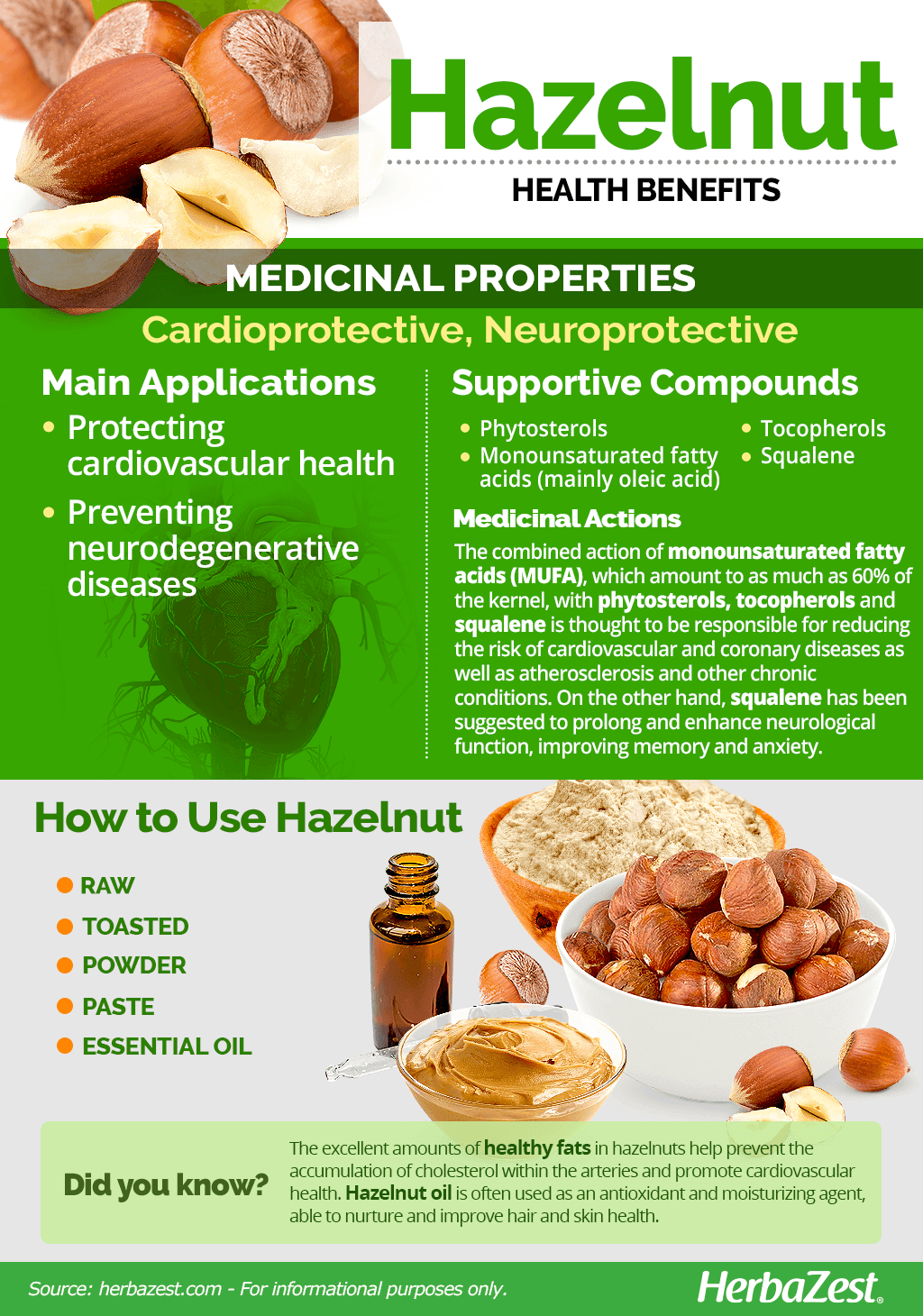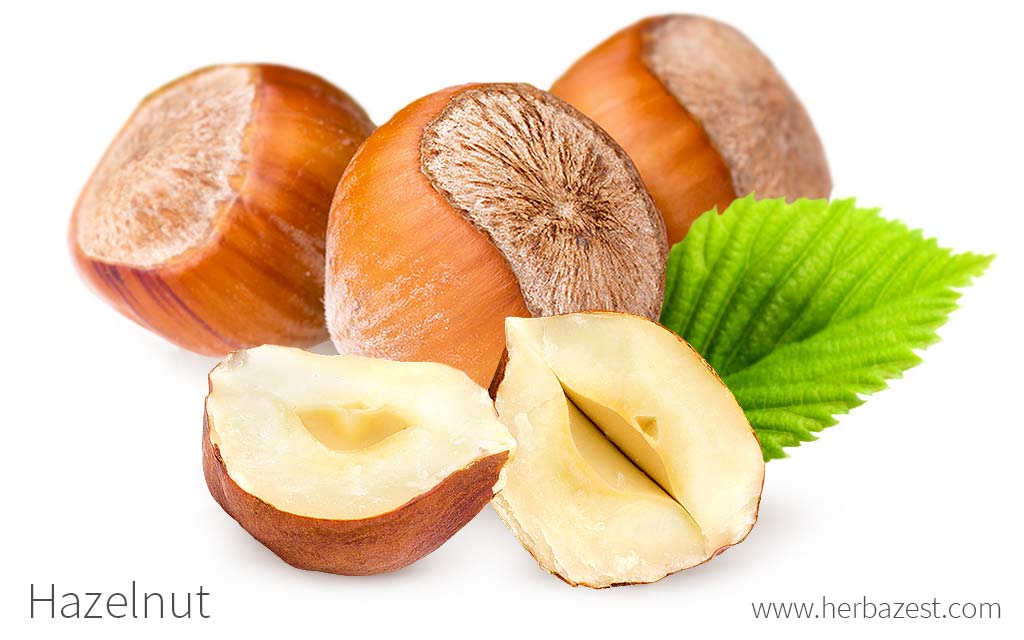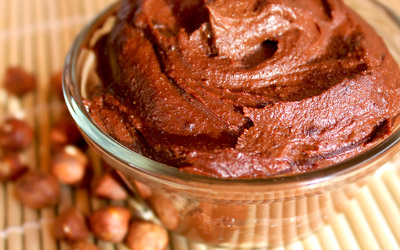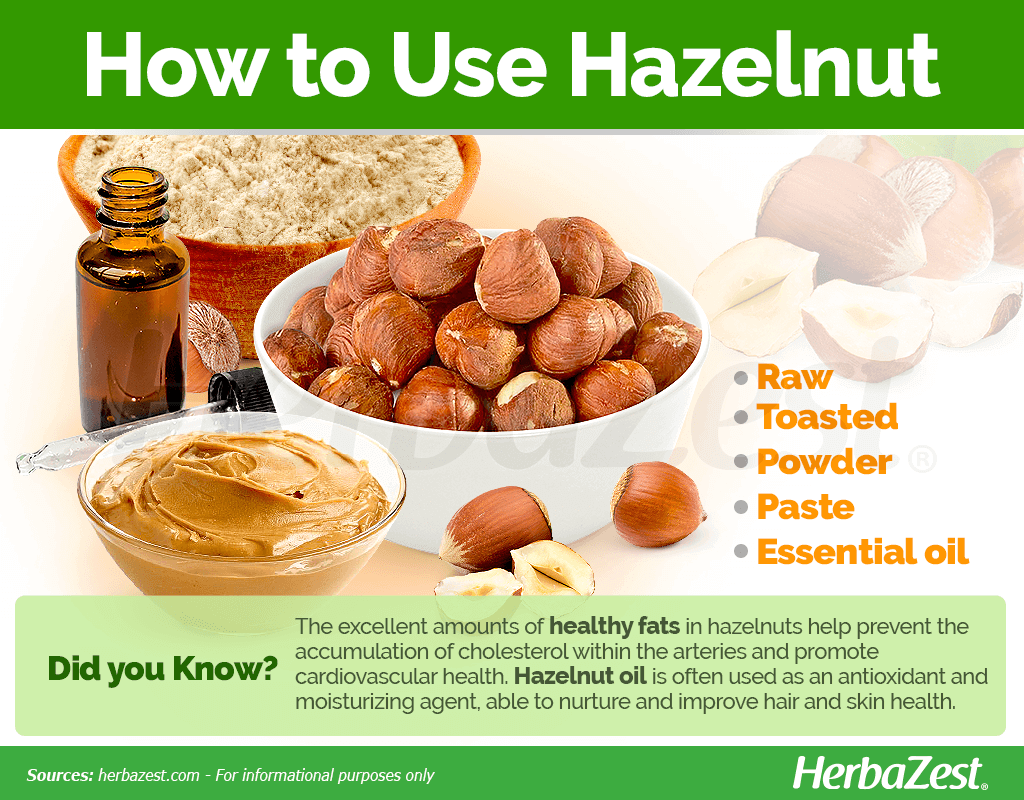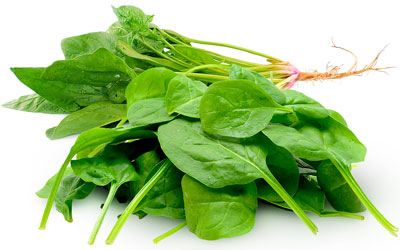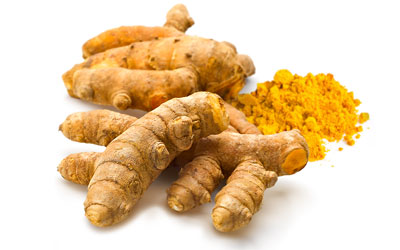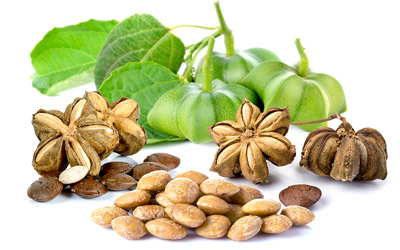The origins of hazelnut, also known as filbert and cobnut, can be traced to Asia and Europe. With a great nutritional value and taste only comparable to the macadamia nut, this tree nut is thought to be highly caloric and fattening, which keeps many people away from its consumption. However, the benefits of hazelnuts have been widely studied by science, and moderate consumption is recommended as part of a balanced diet.
Hazelnut Medicinal Properties
Health Benefits of Hazelnut
In spite of the popular perception of nuts being unhealthy, scientific research has proven they are not only good for improving metabolic markers, but also for preserving cognitive functions. Within that context, the most remarkable hazelnut benefits are:
Protecting cardiovascular health. The concentration of healthy fats in hazelnut kernels helps regulate cholesterol levels and improves metabolic markers, thus preventing coronary and vascular diseases.
Preventing neurodegenerative diseases. Hazelnut benefits include neuroprotective properties that help prevent and even reverse age-related diseases, such as Alzheimer's.
Hazelnut health benefits also include:
Maintaining a healthy weight. Contrary to popular belief, hazelnut's richness in fatty acids has been suggested to help prevent weight gain. Moderate consumption of filbert nuts can also reduce the risk of metabolic diseases.
Moisturizing skin and hair. Hazelnut essential oil is rich in unsaturated fatty acids, highly beneficial for moisturizing skin and hair, and it is used in a variety of personal care products.
TRADITIONAL PERSIAN MEDICINE MANUSCRIPTS ARE THE FIRST WRITTEN RECORDS OF HAZELNUT'S CONSUMPTION FOR REVERSING BRAIN ATROPHY AND MEMORY LOSS.
How It Works
Hazelnut health benefits are mainly related to its high levels of mostly monounsaturated fatty acids (MUFA), which amount to as much as 60% of the kernel. Other key compounds on hazelnut are phytosterols, tocopherols, and squalene.
The combined action of these compounds in hazelnut kernels (mainly oleic acid) have been shown to reduce the buildup of low density lipoproteins (LDL), or "bad cholesterol", while maintaining stable levels of high-density lipoprotein (HDL), also known as "good cholesterol."1 This action is thought to be responsible for reducing the risk of cardiovascular and coronary diseases as well as atherosclerosis and other chronic conditions.
On the other hand, the traditional consumption of hazelnuts, or filbert nuts, for prolonging and improving neurological function has been validated by scientific research.2 These effects have been attributed to their great amount of antioxidant compounds, particularly squalene, a polyunsaturated hydrocarbon with antioxidant and neuroprotective properties, which can be found in certain fish and vegetable oils. Additionally, it has been suggested that daily hazelnut consumption leads to an improvement in memory and anxiety.2
HAZELNUTS ARE THE SECOND RICHEST SOURCE OF MONOUNSATURATED FATTY ACIDS AFTER MACADAMIA NUTS.3
Furthermore, squalene is widely used in the cosmetic industry - along with hazelnut's fatty acids - as an antioxidant and moisturizing agent, able to nurture and improve hair and skin health.
Other herbs with cardioprotective, cholesterol-lowering benefits are kaniwa, flax, and oats, whereas neuroprotective properties can also be found in almonds, macadamia nuts, and walnuts.
Hazelnut Side Effects
Hazelnut is considered generally safe for most people; however, it might trigger allergic reactions in individuals sensitive to tree nuts. Symptoms may include moderate itching and swelling of mouth and lips, mild gastrointestinal discomfort, and difficulty swallowing.
Hazelnut Cautions
Hazelnut kernels, like other tree nuts, also contain potentially toxic amounts of oxalate, which can affect sensitive people as well as those who suffer from kidney stones. Children with asthma and food allergies should avoid consuming all kind of tree nuts.
- Medicinal action Cardioprotective, Neuroprotective
- Key constituents Phytosterols, monounsaturated fatty acids, tocopherols, and squalene
- Ways to use Food, Powder, Essential oil
- Medicinal rating (2) Minorly useful plant
- Safety ranking Safe

Hazelnut Nutrition
The nutritional value of hazelnuts hails from their high concentrations of essential minerals and vitamins. Hazelnut kernels provide adequate amounts of protein and are also a good source of dietary fiber, but their most important contribution to human health are their excellent amounts of healthy fats, mostly monounsaturated, which help prevent the accumulation of cholesterol within the arteries and promote cardiovascular health.
The most abundant minerals in hazelnuts, or filbert nuts, are copper and manganese, both involved in the development of strong bones as well as the health of vascular and nervous systems. Hazelnut kernels also provide adequate amounts of potassium, iron, and zinc.
Although tree nuts are usually not as generous in vitamins as they are in minerals, filbert nuts do offer excellent amounts of vitamin E (alpha-tocopherol), which boosts the immune system so that it can fight off invading bacteria and viruses, while also preventing blood clotting within the arteries. Hazelnut nutrition is rounded by good amounts of vitamin B6 (pyridoxine), necessary for proper brain development and function, along with adequate values of vitamins B1 (thiamin) and B9 (folate).
ONE OUNCE (28.35 G) OF HAZELNUT KERNELS PROVIDE 183 CALORIES AS WELL AS 11 AND 9% OF THE DAILY VALUE FOR DIETARY FIBER AND PROTEIN, RESPECTIVELY.
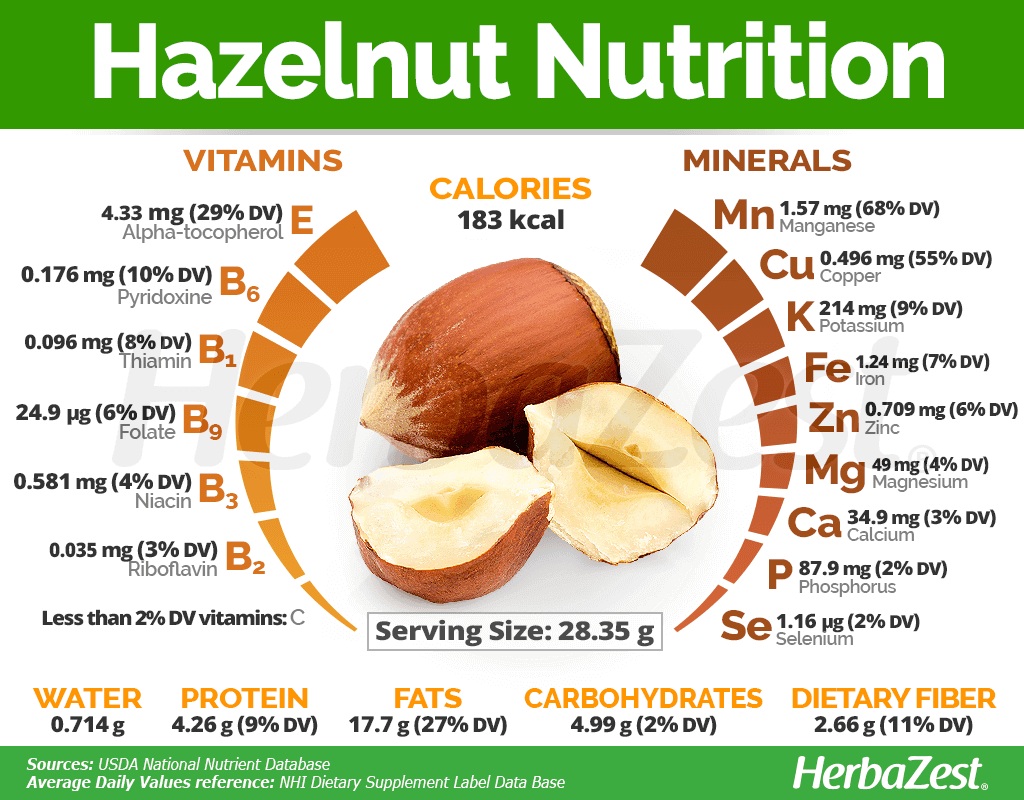
How to Consume Hazelnut
Hazelnut has been traditionally consumed either raw or roasted, alone or combined with dried fruits, as well as used in a wide variety of culinary preparations.
Natural Forms
Raw. In their fresh form, hazelnut kernels are a popular snack that provide great nutrition and medicinal benefits.
Toasted. This is a traditional way of reaping hazelnut health benefits. In this form, the oxalate content is significantly reduced, making the nutritional value of hazelnuts more bioavailable. However, care should be taken with packaged filbert nuts, which can be high in sodium.
Powder. After hazelnut kernels are ground, they are often used as an ingredient in baked goods, smoothies, and many other culinary preparations.
Paste. Hazelnut can be made into a creamy, buttery paste to be spread on toasts and crackers, as well as used in baked goods.
Herbal Remedies & Supplements
Essential oil. Hazelnut oil is rich in fatty acids and vitamin E, which makes it ideal for hair, nails, and skin nourishment through topical application. Being a neutral carrier oil, it can be used to dilute other essential oils in order to prevent skin reactions.
HAZELNUT OIL HAS A MEDIUM SMOKING POINT AND CAN BE PERFECTLY USED FOR COOKING AND BAKING, AS WELL AS FOR SALAD DRESSINGS.
- Edible parts Fruit
- Edible uses Oil
- Taste Sweet
Growing
The filbert, hazelnut, or common hazel tree is a deciduous species, of medium size suitable for both landscapes and large home gardens. The hazelnut tree thrives in temperate climates, with a moderate level of humidity. Although hazelnuts are the second most produced nuts worldwide after almonds, they can be seen growing freely in woodland areas and other open spaces.4
Growing guidelines
The hazelnut tree grows better in deep, well-drained soil, in a field free of rocks with pH of 6.5 to 7.0 and full sun exposure.
Temperature requirements and hardiness zones vary depending on the variety. While the American hazelnut is hardy to zones 4 to 8, its European counterpart prefers zones 5 to 10.
Hazelnuts can be propagated by seed, but the rate of success is so low that the most popular method is through seedlings.
The space between trees should be within the range of 5-10 feet (1.5-3 m).
Young hazelnut plants need regular irrigation, especially during the first years, in order to allow their roots to grow deep enough, ensuring survival.
Hazel flowers are wind-pollinated, without the help of bees or butterflies, and bloom in the early spring.
The common hazel tree starts bearing fruits as little as four years after planting and provides heavy yields in the sixth or seventh year.
The small hazelnut bush, with an average height of 8-12 feet (2.4 – 3.7 m), allows for easy hand picking of the nuts, and it is preferred for ornamental hedging as well as for erosion control.
Eastern Filbert Blight (EFB) is a fungal infection, characterized by the presence of small raised bumps on any part of the tree, and it is the main disease that attacks hazelnut.
Some animals, such as squirrels, deer, moles, voles, and mice, find eat not only the filbert nuts, but also hazelnut leaves, buds, and bark. It is vital to protect the common hazel tree from these animals during its first three years of life, until it is large enough to withstand such attacks.
- Life cycle Perennial
- Harvested parts Fruit
- Light requirements Full sun
- Soil pH 6.6 – 7.3 (Neutral)
- Growing habitat Temperate climates, Woodlands
- USDA Plant Hardiness Zones 4a, 4b
- Plant spacing average 5 m (16.4 ft)
- Growing time 4 years
- Potential diseases Fungi
- Potential animal pests Deer, Moles, Mice, Squirrels, Voles
Additional Information
Plant Biology
The hazelnut tree, or common hazel tree, is a perennial that can reach up to 15-20 feet (4.6-6 m); however, it grows up to 8-12 feet (2.4 – 3.7 m) in a bush form.
In North America, the hazelnut tree grows naturally in humid or dry woodland areas and edges, as well as in prairies, hills, and along riverbanks. Hazelnut tree leaves are simple, alternate, and deciduous, with saw-toothed edges and very fuzzy surfaces, and the twigs frequently grow in a zig-zag fashion. The filbert or hazelnut fruit is a large nut enclosed in a papery husk.
Classification
The filbert or hazelnut tree (Corylus avellana) belongs to the Betulaceae, or Birch family, which is divided into two subfamilies: Betuloideae and Coryloideae, and compresses over 167 species, across six genera of deciduous trees and shrubs, some of them grown for their edible nuts.
The Coryloideae subfamily still under investigations, but it is thought to comprise between 9 and 25 species, with two of them being the most economically important: the American hazelnut (Corylus americana, known as Corylus cornuta if beaked), which is native to the northeastern and midwestern United States, and the filbert nut, which is native to Asia and Europe and bears the botanical name of Corylus avellana or Corylus maximus, depending on its size.
THE GENUS NAME CORYLUS COMES FROM THE GREEK WORD "KORYS" (HELMET OR HOOD).
Cultivars of hazelnuts
Although American hazelnuts (Corylus americana) are hardy, disease resistant trees, highly tolerant to a variety of environmental conditions, European hazelnuts, or filbert nuts (Corylus avellana), are bigger and tastier, and because of their great quality, they have been preferred for millennia. For this reason, both species have been subjected to intense hybridization during the past century, resulting in a large number of commercial cultivars. 'Barcelona' is a Spanish cultivar and arguably the most popular one in the United States, with nuts that are medium to large size. Other cultivars that produce large nuts are 'Ennis' and 'Gem,' whereas 'Hall's Giant,' 'J-5,' and 'Tonda di Giffoni' are medium sized, and some cultivars with small nuts are 'Casina,' 'Clark,' 'Lewis,' and 'Sacajawea.'
Historical information
The origins of hazelnut tree can be traced to prehistoric Asia and Europe. Archeological evidence indicates that after the glacial period, this hardy tree was endemic across the British Isles and even parts of Scandinavia. Hazelnuts were consumed by Europeans during the Stone Age, 10,000 years ago. However, the first written reports of human hazelnut cultivation come from China, over 5,000 years ago. Filbert nuts were also consumed by ancient Greeks and Romans about 2500 years ago. First century Greek documents mention that hazelnuts were brought to that part of Europe from present-day Turkey.
A CHINESE MANUSCRIPT DATED 2,838 BCE INCLUDES HAZELNUTS AMONG CHINA'S FIVE SACRED FOODS.
It is thought that the word "hazelnut" comes from the Anglo-Saxon word haesel (bonnet), in reference to the particular shape of this nut's husk, which entirely covers the fruit in some varieties and it is also believed to give origin to the other common name, "filbert", that means vollbart (full bear) in German. Another popular theory suggests that the name filbert is derived from the annual date of celebration of St. Philibert, August 20th, coinciding with the time the earliest hazelnuts ripened in England.
The species' name of hazelnut comes from the Latin abellana, in reference to the town of Abella, in Campania (Italy), famous for its hazelnuts.
Although local wild hazelnuts were an important source of nutrition and timber to Native American people for millennia and also for the first European settlers, hazelnuts have been commercially cultivated in the U.S. only since 1858, when Sam Strickland, a retired English sailor, planted the first hazelnut tree in the Pacific Northwest in Scottsburg, Oregon.
Popular Beliefs
During the Middle Ages, supernatural powers were attributed to the hazelnut tree, and its wood was used to make "magic" rods and utilized to locate highly valued minerals. The filbert nuts, on the other hand, were touted as a symbol of fertility and commonly consumed in wedding ceremonies.
Economic Data
Turkey is the main producer of hazelnuts, with 625,000 metric tons, or 74% of the annual world market, followed by Spain, Azerbaijan, and the United States.5
About 99% of hazelnut production in the U.S. is done in the Willamette Valley region of Oregon because of the ideal climate, followed by Washington as a second biggest producer of filbert nuts in North America. These two states account for roughly 5% of the world's production.
DUE TO ITS ECONOMIC IMPORTANCE, THE HAZELNUT BECAME THE OFFICIAL STATE NUT OF OREGON IN 1989.
Other Uses
Cosmetic industry. Hazelnut essential oil is an ingredient of many personal care products, due to its antioxidant, moisturizing properties.
Alcoholic beverage. Filbert nuts are the main ingredient of a famous Italian liqueur called Frangelico.
Gardening. Small bush-like hazelnut varieties are popular for hedging, as well as for erosion control.
- Other uses Alcohol, Cosmetics
Sources
- Cornell University, Cornell Small Farms Program, Hazelnut Trees Are Easy!
- International Journal of Cosmetic Science, Influence of hazelnut oil phospholipids on the skin moisturizing effect of a cosmetic emulsion
- International Journal of Food Sciences and Nutrition, Fatty acid profile, tocopherol, squalene and phytosterol content of walnuts, almonds, peanuts, hazelnuts and the macadamia nut, 2004
- New Crops News, Nuts with Commercial Potential for America's Heartland, 1994
- North American Cornucopia: Top 100 Indigenous Food Plants, pp. 352-356
- Oregon State University, Common Trees of the Pacific Northwest, Filbert/Hazel (Corylus)
- Pharmacological Research, Almond, hazelnut and walnut, three nuts for neuroprotection in Alzheimer's disease: A neuropharmacological review of their bioactive constituents, 2017
- The Encyclopedia of Healing Foods, pp. 428-432
- Tree Nuts: Composition, Phytochemicals, and Health Effects, pp. 190-205
- University of Wisconsin, Five things everyone should know about… Hazelnuts
- USDA Food Data Central, Nuts, hazelnuts or filberts
- Wild Crop Relatives: Genomic and Breeding Resources: Forest Trees, p. 16
- Advances in Food and Nutrition Research, Biological importance and applications of squalene and squalane, 2012
Footnotes
- Nutrients. (2016). Effects of Hazelnut Consumption on Blood Lipids and Body Weight: A Systematic Review and Bayesian Meta-Analysis. Retrieved February 06, 2020 from https://www.ncbi.nlm.nih.gov/pmc/articles/PMC5188407/
- Nutritional Neuroscience. (2017). Hazelnut and neuroprotection: Improved memory and hindered anxiety in response to intra-hippocampal Aβ injection. Retrieved February 06, 2020 from https://www.ncbi.nlm.nih.gov/pubmed/26808646
- British Journal of Nutrition. (2006). Fatty acid composition of nuts - implications for cardiovascular health. Retrieved February 06, 2020 from https://www.cambridge.org/core/services/aop-cambridge-core/content/view/S0007114506003564
- Small, E. (2014). North American Cornucopia: Top 100 Indigenous Food Plants. Boca Raton, FL: CRC Press. Available from Google Books
- University of Nebraska - Lincoln. (2009). Evaluating Hazelnut Cultivars for Yield, Quality and Disease Resistance. Retrieved February 10, 2020 from https://digitalcommons.unl.edu/cgi/viewcontent.cgi?referer=https://www.google.com/&httpsredir=1&article=1010&context=envstudtheses
